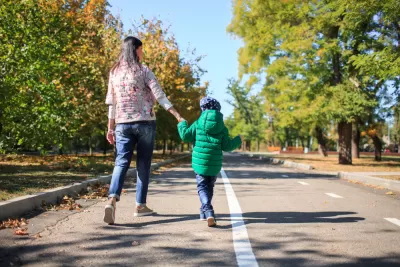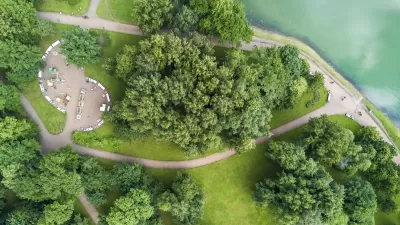A new study by researchers in Virginia found that walking in a quiet urban setting with shade and greenery can significantly improve mood and reduce stress.

If you are taking walks to de-stress, where you do it matters. A new study by researchers from the Science Museum of Virginia, Virginia Commonwealth University, University of Virginia and Virginia Tech found that walking in a quiet urban setting with shade and greenery can significantly improve mood and reduce stress, while walking in a noisier urban setting without shade and plants or green space can increase exposure to heat, air pollution and traffic noise, thereby increasing stress levels and heat-related discomfort.
As reported by Mary Kate Brogan, the study, “The Impact of Urban Walking on Psychophysiological Well-Being,” published in Cities & Health in September 2022, suggests that environment matters when exercising for mental health and supports a growing body of evidence that planning urban environments to incorporate green space can improve residents’ overall health.
This study builds on research in older adults extending the protocol to healthy adults exploring the impacts of walking in varying environmental conditions on psychophysiological outcomes (mood, working-memory and heart rate variability (HRV)). Participants undertook a 20 to 30-minute walk in both an urban green and gray setting, one week apart, with varying levels of air pollution and heat. Walking in the urban green setting increased positive mood and HRV and decreased self-reported stress and arousal. Thermal sensation in the urban green setting was lower compared to the urban gray setting.
The results of the study build on evidence that there are potential beneficial effects of urban green settings with respect to heat and particulate matter (PM2.5). These results show psychophysiological benefits of short walks within urban green settings, during the COVID-19 pandemic, which has implications for public health and how people engage with our local environments for physical activity.
For more information, please read the source article.
FULL STORY: Walking in urban green spaces is better for us than walking in gray spaces

Alabama: Trump Terminates Settlements for Black Communities Harmed By Raw Sewage
Trump deemed the landmark civil rights agreement “illegal DEI and environmental justice policy.”

Planetizen Federal Action Tracker
A weekly monitor of how Trump’s orders and actions are impacting planners and planning in America.

The 120 Year Old Tiny Home Villages That Sheltered San Francisco’s Earthquake Refugees
More than a century ago, San Francisco mobilized to house thousands of residents displaced by the 1906 earthquake. Could their strategy offer a model for the present?

In Both Crashes and Crime, Public Transportation is Far Safer than Driving
Contrary to popular assumptions, public transportation has far lower crash and crime rates than automobile travel. For safer communities, improve and encourage transit travel.

Report: Zoning Reforms Should Complement Nashville’s Ambitious Transit Plan
Without reform, restrictive zoning codes will limit the impact of the city’s planned transit expansion and could exclude some of the residents who depend on transit the most.

Judge Orders Release of Frozen IRA, IIJA Funding
The decision is a victory for environmental groups who charged that freezing funds for critical infrastructure and disaster response programs caused “real and irreparable harm” to communities.
Urban Design for Planners 1: Software Tools
This six-course series explores essential urban design concepts using open source software and equips planners with the tools they need to participate fully in the urban design process.
Planning for Universal Design
Learn the tools for implementing Universal Design in planning regulations.
Clanton & Associates, Inc.
Jessamine County Fiscal Court
Institute for Housing and Urban Development Studies (IHS)
City of Grandview
Harvard GSD Executive Education
Toledo-Lucas County Plan Commissions
Salt Lake City
NYU Wagner Graduate School of Public Service





























